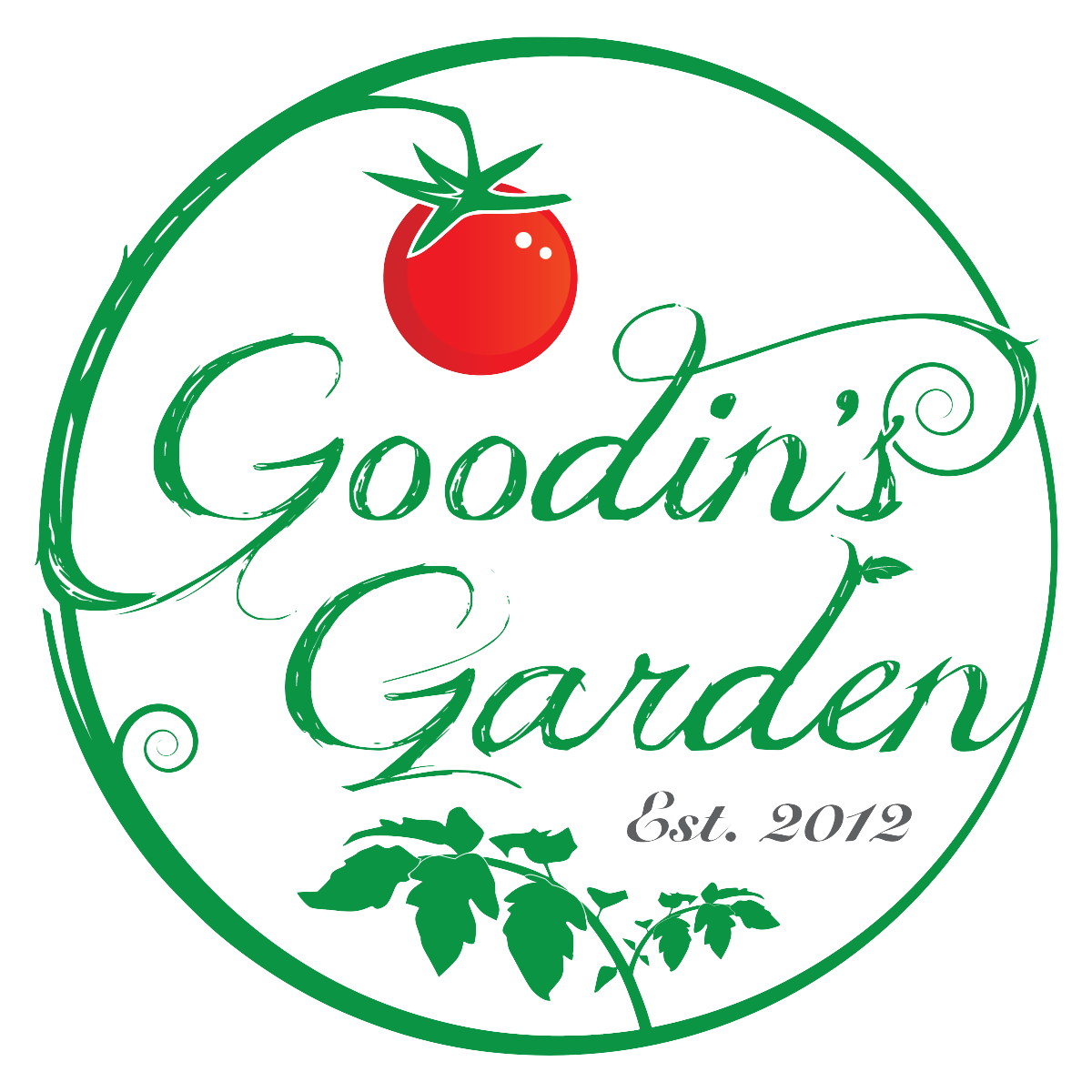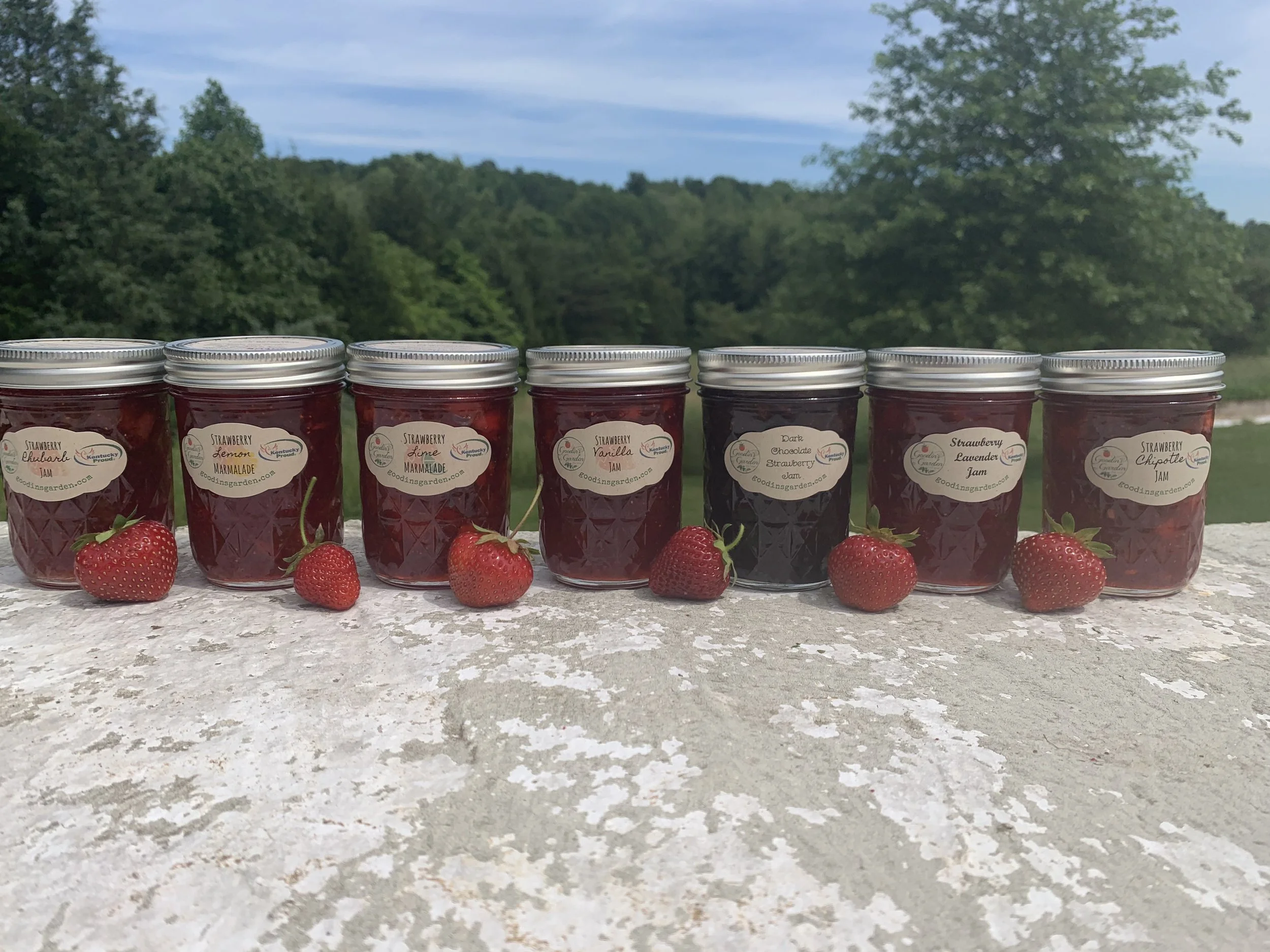Canned Goods by the Season
Everything you ever wanted to know about our home canned goods!
Jam, jelly, preserves, marmalade… all the different names can get confusing when you are just looking for something yummy to put on a biscuit or pour over cream cheese. Here is your guide to all things canned to help better understand what’s available and how to best use your canned goods.
Strawberry Jam lineup 2021
The Basics
Currently, I am considered a home based processor and home based microprocessor that is allowed to sell the canned goods I produce in Kentucky, in person. I cannot ship canned goods or wholesale under these licenses. As of 2021, all canned goods are made in our dedicated canning kitchen on the farm. Home based processing covers all things considered low risk: fruit jams and jellies, syrups, dried herbs and food, salad mixes, candy, and baked good. Home based microprocessing covers all things considered slightly higher risk: pepper jellies, pickles, salsa, low-sugar preserves, etc. For home based microprocessing, a class on canning safety is taken and renewed every 3 years and all recipes are submitted to University of Kentucky for approval where they are checked to make sure they are safe for home canning. For both licenses, my kitchen is inspected and the water source is verified to make sure the area is clean and safe for canning. Some things that are not covered under either home based licenses are canned meat and fermented food. I only sell water bath canned products. I do pressure can for food preservation for my family and I am always happy to answer any pressure canning questions you may have - or direct you to a reliable source.
The Label
Every jar has a label that lists the name of the product, our farm and address, the ingredients, size, and when it was made. If there are any major allergens, it will be listed on the jar in red. The only major allergen that appears in our jams is milk, as a thin sliver of butter is used to reduce foaming in most of our strawberry jams. I do make strawberry jams without butter regularly as well, and that may be more common in 2023 with butter shortages and prices. Canned goods last a long time, like years, unopened, and months once opened and stored in the fridge. Under Kentucky law, you can sell any product made within the last 2 years. For the 2023 market season, you will see jars made in 2022, and they are perfectly safe and taste just as fresh as the jar made the week prior. Once you open a jar, please refrigerate it and make sure the rim of the jar stays clean and it should last for several months in the fridge. One other thing about canning jars is that the jar has a 2 part lid (this type of lid is required under home based licenses.) The two part lid consists of the lid and the ring. Unopened jars are typically stored without the ring on and the jar is just as sealed at the market weather that ring is lose or tight.
The Ingredients
As for the ingredients, water bath canning is based on making sure the product is acidic enough that it would inhibit any bacterial growth once heated properly in a water bath canner and the jar seals. Therefore, it is common to see lemon juice, lime juice, and vinegar on the labels for water bath canned items. Not every fruit needs lemon juice to get to the right acid level for jams and jellies, but a lot do. Salsas typically have vinegar or lime juice as tomatoes are not acidic enough to safely water bath can on their own. Pickles are in a brine of vinegar and water. Pectin is an ingredient you will see in most jams and jellies made by me as well. Pectin helps with jelling and drastically reduces cooking time (boiling for 20 minutes to an hour vs boiling for a minute.) Sugar aids in preserving the fruit and for the fruit to jell. While sugar is often the first or second ingredient on the label that doesn’t always mean you are buying a jar of straight sugar. For example, curried tomato preserves is primarily tomatoes and sugar is the 2nd ingredient. Per serving, there is approximately 3 g of sugar. Most jams have around 10 g of sugar per serving, which is sugary, but it is less than grocery store products (and I use granulated sugar, not a combo of a bunch of different sugars and food colorings.) Now if you eat the whole jar in one sitting… that’s a whole different story and not advised if you are trying to limit sugar. I am working to offer some more jams that have less sugar, using honey, maple syrup, or agave syrup in lower quantities than standard granulated sugar. I won’t ever have a sugar free jam because fruit itself has sugar in it and sugar substitutes like splenda cannot be used in home canning. If are looking to avoid sugar, hot sauce, pickles, and other more savory options are a good alternative.
A Cheat Sheet to the Different Names
Jelly - made with the juice of the fruit, generally has a firm set and a see through appearance
Jam - made with crushed or chopped fruit, a softer set than jelly
Preserves - made with whole or large slices of fruit
Marmalade - made with the rind of citrus fruit - this can range from slices of citrus to thin peels
Conserve - a jam with dried fruit and/or nuts
Fruit Butter - pureed fruit cooked slowly to create a smooth, thick spread
Canned Goods are Seasonal?
Yes! One of the cool things about the Hardin County Farmers Market is that it is a Producer-Only market, which means that everything you buy there the farmer grew, raised, and produced. For canned goods, that means a primary ingredient in that jar is grown on the farm and preserved. That also means if I don’t grow it, you won’t see it at the farmers market. For winter markets and anything outside of the farmers market, that same rule does not apply to home based processed items (home based microprocessing always has to have a primary ingredient grown by the farmer), which is why you will see a lot of delicious canned goods of items I do not grow only at those markets (or available for preorder online.) For jams, jellies, and hot sauces, I can freeze berries and peppers and use them throughout the year. As long as I don’t run out of the frozen item, I can offer most of these jams year round. Pickles, relishes, and salsas are a different story - they can only be canned when that item is growing and a general rule of thumb is to preserve within 24 hours of harvesting to produce a top quality product. If I froze cucumbers to can up as pickles for later, it would be a jar of mush, same with jalapeño candy.
Spring
April bring rhubarb. May brings strawberries. These are the two crops that get the most attention in the spring months. Most other jams and jellies during these months will be made from frozen berries and peppers.
Summer
June brings cucumbers, blueberries, blackberries, green sweet peppers, and green beans. July bring hot peppers, sweet peppers, and tomatoes. August brings the red, orange, and yellow hot peppers, and many more tomatoes. During the summer months, the focus tends to be more on canning those things that can’t be canned any other time of year, so jam selections may be lower. A lot of nights are spent pickling, making relish, and batch after batch of jalapeño candy. Free Sundays on the weekend are used to make salsas, curried tomato preserves, and other tomato products.
Fall & Winter
September is usually when we harvest the last of all the hot peppers and spend time putting up whatever else is left in the garden. We also get a second batch of blackberries in the fall. September and October the focus in the canning kitchen shifts to making products for winter and holiday markets. This is when a lot of canned goods are made with items I do not grow, such as apple butters, apple jellies, cranberry sauce, and gingerbread jelly to name a few. November and December is focusing on making more of what may have sold out the week before, but generally canning is winding down somewhat during these months. January, February, and March goes back to focusing on canning with items from the freezer for the winter markets and to start to build up some stock for April and May markets.
Some Suggested Uses
Jam is not just for biscuits. I repeat: jam is not just for biscuits. The possibilities on ways to use jam are endless, so even if you aren’t a big bread eater - there is probably a jam for you.
Some of the many ways we use jams, jellies, and other preserves at Goodin’s Garden:
As a glaze for BBQ, combine pepper jelly with jalapeño syrup and your chicken wings, ribs, and pork loins will be out of this world flavorful! We will combine an entire jar of the pepper jelly with some jalapeño syrup (just enough to thin it into a sauce) and put it in a squeeze bottle. That way there is no cross contamination with meat, and we keep the bottle in the fridge.
As a topper on meatloaf instead of ketchup - this works for both regular jellies and for pepper jellies.
On a burger - add some pepper jelly to your next cheese burger. My favorite is the blueberry pepper.
As a pancake, waffle, or french toast topper. Dark chocolate strawberry jam, raspberry sunshine jam, and blueberry lemon jam have all made delicious appearances on waffles in my house. Dark chocolate strawberry jam is also really good in crepes.
On a grilled cheese sandwich or quesadilla. This is especially popular with cherry mango jalapeño jelly.
As a salad dressing. Mix some of your favorite jam with a little vinegar and oil for an easy salad dressing.
As a seasoning, you can dress up almost any meal with a little bit of jam.
Mix it in with yogurt or oatmeal. Add a little flavor to your plain yogurt or oatmeal.
Over ice cream. Dark chocolate strawberry jam + vanilla ice = meant to be.

